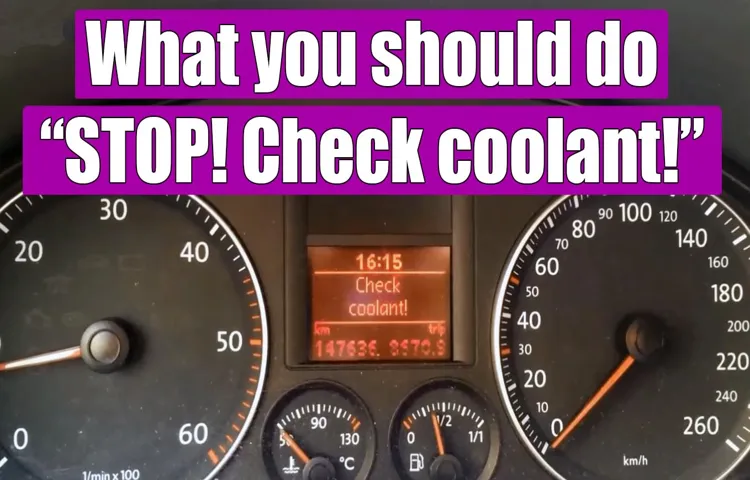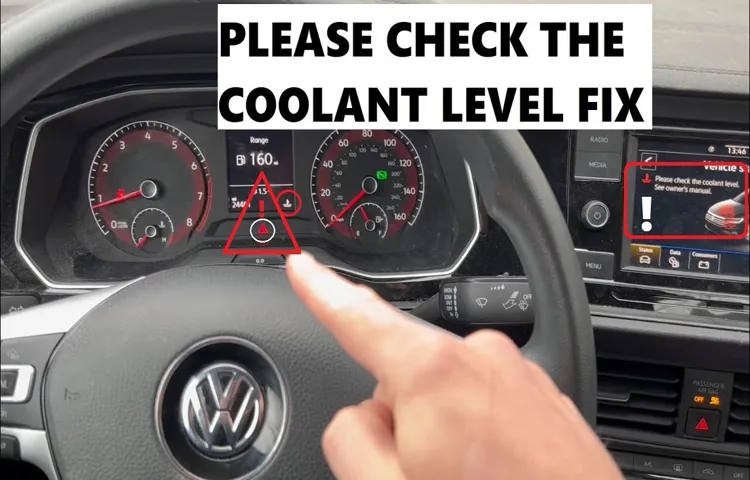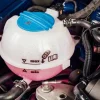Hey there, Volkswagen Jetta owners! Are you unsure about how to check the coolant level in your beloved car? Don’t worry, we’ve got you covered. Your Volkswagen Jetta’s cooling system plays a crucial role in keeping your engine running at the optimal temperature, preventing it from overheating and potentially causing serious damage. Imagine your car’s cooling system as the body’s thermometer.
Just like our bodies need to maintain a healthy temperature for optimum performance, your vehicle’s engine operates best within a specific temperature range. And the coolant is like the body’s coolant, constantly flowing through the system, absorbing and dissipating excess heat. So, how do you make sure your coolant level is on point? Well, it’s a relatively simple task that you can easily do at home.
First, park your Jetta on a flat surface and make sure the engine is cool before popping the hood. Safety first, after all! Once you’re ready, locate the coolant reservoir. In most Jetta models, it’s a transparent plastic tank labeled with “coolant” or “antifreeze.
” Depending on your Jetta’s model year, the reservoir can be located either on the passenger side or driver’s side of the engine compartment. It should be fairly easy to spot once you open the hood. Now that you’ve found the coolant reservoir, it’s time to check the coolant level.
The reservoir will have markings indicating the minimum and maximum levels. The coolant level should ideally fall between these two marks. If it’s below the minimum level, you’ll need to add more coolant.
Remember, never remove the coolant reservoir cap when the engine is hot, as the cooling system is under pressure and can cause serious injuries. Make sure to wait until the engine has cooled down before proceeding. If you need to add more coolant, use a mixture of equal parts coolant and water.
Table of Contents
Introduction
Are you a proud owner of a Volkswagen Jetta? If so, then you know how important it is to regularly check the coolant level in your vehicle. The coolant plays a crucial role in maintaining the optimal temperature of your engine, preventing it from overheating. If the coolant level is too low, it can lead to engine damage and subsequent expensive repairs.
So, how do you check the coolant level in your Volkswagen Jetta? It’s actually quite simple. First, make sure that your engine is cool and turned off. Then, locate the coolant reservoir.
It is typically a translucent plastic tank with a cap labeled “coolant” or “antifreeze.” Open the cap and visually inspect the coolant level. It should be between the minimum and maximum markings on the reservoir.
If it’s low, you’ll need to add more coolant. Just remember to use the recommended coolant type for your vehicle, which can usually be found in your car’s manual. Regularly checking the coolant level in your Volkswagen Jetta is an essential part of car maintenance and can help prevent potential engine problems down the line.
Overview of coolant and its importance
coolant, importance, overheating, engine, temperature, automotive, system, maintenance, prevent, damage Introduction: Have you ever wondered how your car engine stays cool even after hours of driving? The secret lies in the coolant, a vital liquid that plays a crucial role in maintaining the engine’s temperature. But what exactly is coolant? And why is it so important? In this blog post, we will dive into the world of coolant and explore its significance in preventing overheating and potential damage to your car’s engine. So, buckle up and get ready to learn all about the importance of coolant in your automotive system maintenance.

Locating the Coolant Reservoir
Knowing how to check the coolant level in your Volkswagen Jetta is an essential part of maintaining your vehicle’s health. To locate the coolant reservoir in your Jetta, start by opening the hood of the car. Once the hood is open, you will need to locate the coolant reservoir, which is a white plastic tank usually located near the front of the engine compartment.
The reservoir should have a cap labeled “coolant” or “engine coolant.” Be cautious when opening the cap, as the coolant may be hot and under pressure. To check the coolant level, ensure that the engine is cool and the car is on a level surface.
Open the cap and visually inspect the coolant level, which should be between the minimum and maximum marks on the reservoir. If the level is below the minimum mark, you will need to add coolant. Be sure to check your vehicle’s owner’s manual for the appropriate type of coolant to use and follow the instructions for proper disposal of any old coolant.
By regularly checking and maintaining the coolant level in your Volkswagen Jetta, you can help prevent overheating and keep your car running smoothly.
Step-by-step guide to finding the coolant reservoir in the Volkswagen Jetta
coolant reservoir, Volkswagen Jetta, locating If you’re driving a Volkswagen Jetta and need to check or refill the coolant, the first thing you’ll need to do is locate the coolant reservoir. Finding it may seem a bit daunting at first, but don’t worry – I’m here to guide you through the process step by step. By the end, you’ll be able to locate the coolant reservoir like a pro! To start, pop open the hood of your Jetta.
Once you have the hood open, take a moment to familiarize yourself with the engine compartment. Look for any prominent plastic or metal components that stand out from the rest of the engine. Now, let’s narrow down our search.
The coolant reservoir in most Volkswagen Jettas is typically located on the passenger side of the engine bay. It’s often a translucent plastic container with a screw-on cap, marked with MIN and MAX levels indicating the appropriate coolant levels. Once you’ve identified the general area where the coolant reservoir should be, take a closer look.
You may need to move a few components or hoses out of the way to get a clear view. Remember, it’s always better to take your time and be thorough rather than rushing through the process. If you’re still having trouble finding the coolant reservoir, try consulting your vehicle’s owner’s manual.
It should provide you with a more detailed diagram or description of its location. You can also search online for specific instructions or watch tutorial videos to help you locate it more easily. Finding the coolant reservoir in your Volkswagen Jetta may initially seem like a challenging task, but with a little patience and guidance, you’ll be able to locate it in no time.
Remember to be thorough in your search and consult your owner’s manual or online resources for extra help if needed. Once you’ve found the coolant reservoir, make sure to check the coolant levels regularly and refill as necessary to keep your engine running smoothly.
Checking the Coolant Level
“How to Check Coolant Level in Your Volkswagen Jetta” Checking the coolant level in your Volkswagen Jetta is an important maintenance task that ensures your engine stays cool and operates properly. To check the coolant level, start by making sure your vehicle is parked on a level surface and the engine is cool. Open the hood of your Jetta and locate the coolant reservoir, which is usually a translucent plastic tank with a cap labeled “coolant” or “engine coolant.
” Carefully remove the cap and visually inspect the coolant level, making sure it is between the minimum and maximum markings on the reservoir. If the level is low, you can add coolant by pouring it directly into the reservoir until it reaches the desired level. It’s important to use the correct type of coolant recommended by Volkswagen for your specific Jetta model.
Additionally, it’s a good idea to check the coolant level regularly and top it off as needed to avoid any potential engine problems. Remember, maintaining the proper coolant level in your Volkswagen Jetta is essential for a reliable and efficient vehicle performance.
Step-by-step instructions on how to check the coolant level in a Volkswagen Jetta
Volkswagen Jetta coolant level check, coolant level in a Volkswagen Jetta, how to check the coolant level in a Volkswagen Jetta One essential maintenance task for ensuring the proper functioning of your Volkswagen Jetta is checking the coolant level regularly. The coolant, also known as antifreeze, is responsible for regulating the temperature of the engine and preventing it from overheating. A low coolant level can lead to engine damage and even failure, so it’s crucial to keep it at the recommended level.
To check the coolant level in your Volkswagen Jetta, follow these step-by-step instructions: Park your vehicle on a flat surface and let the engine cool down completely. It’s essential to ensure that the engine is not hot to avoid any burns.
Open the hood of your Jetta and locate the coolant reservoir. It is usually a translucent plastic container with high and low level markings.
The reservoir is typically located near the radiator cap. Once you find the coolant reservoir, check the coolant level by looking at the markings on the side of the container.
The high and low level markings indicate the recommended range for the coolant level. If the coolant level is below the low mark, you need to add coolant.
Make sure you use the correct coolant type specified in your Volkswagen Jetta’s owner’s manual. To add coolant, unscrew the cap on the coolant reservoir.
Adding Coolant
Are you a proud owner of a Volkswagen Jetta and want to make sure your coolant levels are in check? Well, you’re in the right place! Checking your coolant level is an important maintenance task that can help prevent overheating issues and potential damage to your engine. It’s a relatively simple process that you can do yourself. First, make sure your car is parked on a level surface and the engine is cool.
Open the hood and locate the coolant reservoir, which is usually a translucent plastic tank with a cap labeled “coolant” or “antifreeze.” The coolant level should be within the designated range marked on the tank. If the level is below the minimum mark, it’s time to add coolant.
Purchase the appropriate coolant for your Volkswagen Jetta and carefully open the cap on the reservoir. Slowly pour the coolant into the tank, being careful not to spill any. Once the coolant level reaches the correct mark, securely replace the cap.
And just like that, you’ve successfully checked and added coolant to your Volkswagen Jetta!
Step-by-step guide on how to add coolant to a Volkswagen Jetta
Volkswagen Jetta, add coolant, step-by-step guide, coolant level, engine temperature, overheating, radiator cap, coolant reservoir, fill line, radiator hose, spilling coolant. If you own a Volkswagen Jetta and notice that the engine temperature is running high, it could be a sign that your coolant level is low. Adding coolant to your Jetta is a simple process that can help prevent your engine from overheating and causing damage.
To start, make sure your engine is turned off and cool before you begin. Then, locate the radiator cap on top of the radiator. Carefully remove the cap and set it aside.
Next, find the coolant reservoir, which is usually a translucent plastic container, and check the coolant level. If it is below the fill line, you’ll need to add more coolant. To add coolant, use a mixture of coolant and water that is recommended for your vehicle.
Slowly pour the mixture into the coolant reservoir, being mindful not to overfill it. It’s important not to spill any coolant, as it can be harmful to the environment. Once you’ve added enough coolant, replace the radiator cap by twisting it back on firmly.
Make sure it is securely in place to prevent any leaks. After adding coolant, it’s a good idea to check for any signs of leaks. Inspect the radiator hoses for any cracks or loose connections.
If you notice any issues, it may be necessary to have them repaired by a professional. Adding coolant to your Volkswagen Jetta is a straightforward process that can help keep your engine running smoothly. By regularly checking and maintaining the coolant level, you can prevent your engine from overheating and potentially causing costly damage.
Tips and Precautions
When it comes to maintaining your Volkswagen Jetta, one important task is checking the coolant level. Coolant is vital for keeping the engine temperature in check and preventing overheating. To check the coolant level on your Volkswagen Jetta, start by making sure the engine is cool.
Open the hood and locate the coolant reservoir, which is usually a translucent plastic container with markings indicating minimum and maximum levels. The coolant should be between these two marks. If the coolant level is low, you will need to add more coolant.
Be sure to use the recommended coolant type specified in your vehicle’s owner’s manual. It’s important to note that coolant should never be added to the radiator when the vehicle is hot, as this can cause severe burns. Finally, remember to check the coolant level regularly to ensure your Volkswagen Jetta is running smoothly and efficiently.
Useful tips and safety precautions to keep in mind while checking and adding coolant
Checking and adding coolant to your vehicle is an important maintenance task that can help prevent overheating and maintain optimal engine performance. Here are some useful tips and safety precautions to keep in mind while performing this task. Firstly, it’s essential to ensure that your engine is completely cool before checking or adding coolant.
Opening the radiator cap or coolant reservoir when the engine is hot can lead to hot coolant spilling out and causing burns. Allow your vehicle to cool down for at least 30 minutes before proceeding. Next, always refer to your vehicle’s owner manual for the correct type and mixture of coolant to use.
Using the wrong coolant can potentially damage your engine and affect its performance. Additionally, it’s important to avoid mixing different types of coolant, as this can lead to chemical reactions and clog the cooling system. When checking the coolant level, make sure your vehicle is on a level surface.
Locate the coolant reservoir, which is usually a translucent plastic tank with min/max markings. If the coolant level is below the minimum mark, it’s time to add more coolant. Use a funnel to pour coolant into the reservoir slowly, taking care not to overfill it.
Lastly, always dispose of used coolant properly. Coolant contains hazardous chemicals that can harm the environment if not disposed of correctly. Check with your local waste disposal facility to find out the proper methods for recycling or disposing of coolant.
In conclusion, checking and adding coolant to your vehicle is a simple yet crucial maintenance task that can help prevent engine overheating. By following these tips and safety precautions, you can ensure a safe and efficient coolant service that keeps your engine running smoothly. So, take the time to regularly check your coolant levels and maintain them as needed to keep your vehicle in top shape.
Conclusion
So there you have it, folks! Checking the coolant level in your Volkswagen Jetta is as easy as a spin on the Autobahn. Just like keeping your engine cool on a summer’s day, it’s important to keep your cool when it comes to car maintenance. So grab a cold drink and give your VW some TLC by checking its coolant level.
Remember, a well-maintained car is a happy car, and a happy car means a happy driver. Happy motoring!”
FAQs
What is the importance of checking the coolant level in a Volkswagen Jetta?
Checking the coolant level is important as it ensures the engine does not overheat and helps maintain optimal performance.
How often should I check the coolant level in my Volkswagen Jetta?
It is recommended to check the coolant level at least once a month or before long trips to ensure it is at the correct level.
How do I check the coolant level in my Volkswagen Jetta?
To check the coolant level, locate the coolant reservoir under the hood, remove the cap, and visually inspect the level against the markings on the reservoir.
What is the correct coolant level for a Volkswagen Jetta?
The coolant level should be between the “min” and “max” markings on the coolant reservoir when the engine is cool.
What should I do if the coolant level in my Volkswagen Jetta is low?
If the coolant level is low, add a mixture of coolant and distilled water in the correct ratio as specified in the owner’s manual until the level reaches the desired range.
Can I use any coolant for my Volkswagen Jetta?
No, it is important to use the coolant recommended by Volkswagen to ensure proper performance and compatibility with the cooling system.
What are the signs of low coolant in a Volkswagen Jetta?
Signs of low coolant include the engine running hotter than usual, dashboard warning lights, and coolant leaks under the vehicle.
Can checking the coolant level help diagnose other engine problems in a Volkswagen Jetta? A8. Yes, checking the coolant level can provide insights into potential engine problems such as coolant leaks or issues with the cooling system.
Is it normal for the coolant level in my Volkswagen Jetta to fluctuate?
It is normal for the coolant level to slightly fluctuate due to expansion and contraction with temperature changes. However, drastic fluctuations may indicate an issue.
Can I drive my Volkswagen Jetta if the coolant level is low?
It is not recommended to drive the vehicle if the coolant level is significantly low as it can lead to overheating and potential engine damage. It is best to top up the coolant level before driving.
Are there any specific precautions to take when checking the coolant level in a Volkswagen Jetta?
Yes, it is important to ensure the engine is cool before checking the coolant level to avoid burns. Additionally, use caution when handling coolant and avoid contact with skin and eyes.
What should I do if I am unsure about checking the coolant level in my Volkswagen Jetta?
If you are unsure or uncomfortable about checking the coolant level yourself, it is recommended to take your vehicle to a qualified mechanic or Volkswagen service center for assistance.



